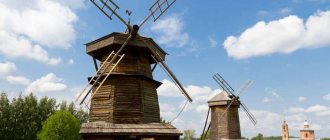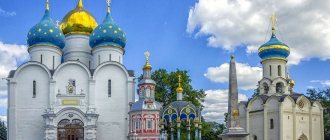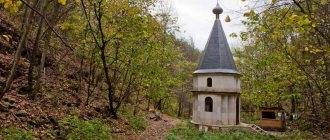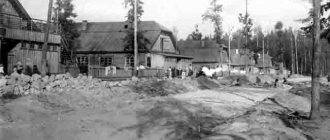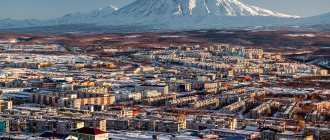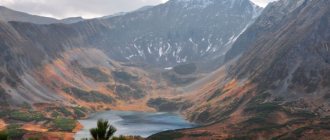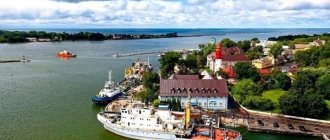Everyone has heard about the cities of the Golden Ring of Russia, but not everyone knows why it is golden and what cities they actually are. There is no direct or literal connection with gold. And in general, until 1967, no Golden Ring of Russia existed as a concept. Even if someone traveled to the cities included in the Ring, they did not obviously call their route that way.
This name was invented by one person - art critic Yuri Bychkov, who, on instructions from the newspaper “Soviet Culture”, in 1967 went in his “Muscovite” to the cities of the Vladimir region and wrote a series of articles about this journey. To be more precise, a series of his travel notes was published under the title “ Golden Ring ”.
Having visited seven cities in the Vladimir region, Bychkov decided not to follow the same route, but to pass through Yaroslavl. So it turned out to be a ring . And there are eight cities, respectively.
On modern maps of this route, other ancient towns are added. On this map, for example, there is Moscow. There are maps where the cities of the Golden Ring of Russia already include 15 cities. But we will still stick to the classic version - 8 cities.
List of cities of the Golden Ring
- Sergiev Posad
- Pereslavl-Zalessky
- Rostov Veliky
- Yaroslavl
- Kostroma
- Ivanovo
- Suzdal
- Vladimir
The Golden Ring of Russia consists of eight ancient Russian cities, with many historical and cultural monuments. And before Yuri Bykov, and even more so now, this route is often traveled by tourists who want to get acquainted with the history of ancient Rus'.
Now briefly about the cities of the Golden Ring of Russia, about each one.
Sergiev Posad
Sergiev Posad is the Orthodox center of the Golden Ring. It is inseparable from the Trinity-Sergius Lavra; a settlement was born and grew under it, which later became a city. In the twentieth century, the city under the name Zagorsk entered the cities of the Golden Ring. In 1991, Sergiev Posad returned the ancient name, but it did not cease to be Zagorsk, maintaining unity in two forms.
Located, according to various sources, 50 km or 70 km from Moscow (Moscow is expanding), the city is more than convenient for visiting. And visiting all the main attractions of Sergiev Posad may well take one day. If you don’t like to leave early, then it’s better, of course, to stay at a hotel and walk around the city the next morning.
The main attraction of Sergiev Posad is rightfully the Holy Trinity Sergius Lavra - a monastery that is still active to this day. The Trinity-Sergius Lavra annually receives more than half a million pilgrims. The irony is that such a busy place was founded as a monastery of Bartholomew of Radonezh, the future St. Sergius, who sought solitude.
Sergiev Posad is not only the Lavra, but also the Sergiev Posad Museum-Reserve, the Chernigov Men's Skete, the Abramtsevo Museum-Reserve, the Toy Museum and, of course, the Krasnogorsk shopping arcade, where all tourists try to buy souvenirs from local craftsmen.
Read more about Sergiev Posad in this article , and here.
Top 5 most beautiful cities of the Golden Ring
Here I’ll tell you about our impressions and preferences, based on our route and not focusing on “included or not included” in the classic Golden Ring, we got the top 5. This is a rating based on the beauty of a place - a combination of natural and man-made attractions:
- Rostov.
- Suzdal
- Bogolyubovo and Pokrova
- Plyos
- Pereslavl-Zalessky
This doesn’t mean that we didn’t like all the other cities, it’s just that these places made the greatest impression.
Yes, there are no ancient world-famous cathedrals in Plyos, but the amazing combination of hills, Volga open spaces, churches (and even delicious corners with bream) makes this city the most beautiful of all visited. This is where we will definitely return!
The amazing Church of the Intercession on the Nerl in the middle of the flooded Bogolyubov meadows is a sight that will take your breath away.
And I don’t want to talk at all, but just absorb this beauty and be glad that it didn’t occur to anyone to build everything here. In general, many sights in Russia were saved only because there was no money to tear down and build. And good.
Suzdal is beautiful not only with top monasteries (which also need to be seen), but also with impassable overgrown paths with observation platforms, where there are almost no tourists, but which are on our maps - and they are the whole charm of this amazing city.
Rostov with an obligatory overnight stay in the Kremlin - and you are guaranteed to love this small but elegant miracle. Walking along the shore of Lake Nero, twilight and reflections...
Pereslavl-Zalessky is also a combination of natural beauty with monasteries and the place where Peter built his first boat.
In general, small towns are in my personal top list. In the big ones, the wonders of the Middle Ages are so built up that there is neither air nor a chance to enjoy them alone - the endless stream of tourists, cars and urban development pretty much spoil the impression.
And yet - perhaps my rating was influenced by the fact that the vast majority of the attractions of the Golden Ring are churches and monasteries; already on the third day of the trip, fatigue sets in, which by the end of the 8th day grew into a great desire to see a piece of Art Nouveau or Gothic, in general - something completely different. And it was nature that very well diluted these impressions, which is probably why I liked such places most of all.
Therefore, perhaps, I will not change the top, but will simply write about each city separately - what is a must-see, and what can be done without.
Pereslavl-Zalessky
Pereslavl-Zalessky was founded in 1152 by Prince Yuri Dolgoruky. Its name alone seems to invite you into a fairy tale, and this first feeling is not deceptive. The prefix to the name of the city was given by a territory called Zalesye, and it sounds almost like “far away lands.”
Pereslavl-Zalessky is famous not only for its beautiful views and architectural masterpieces, many of which are almost 10 centuries old. The city is small, more like a town, but it has a surprisingly rich history.
Pereslavl was ravaged by enemies, burned, but was rebuilt and strengthened again. Grand Dukes and Tsars have visited Pereslavl more than once, and at times even lived. For example, Ivan III, Vasily III, Ivan the Terrible. According to their decrees, fortifications and temples were erected in the city and its environs.
The historical and architectural monuments of Pereslavl-Zalessky are widely known. An outstanding military-defensive structure is the 12th-century earthen ramparts, about 2.5 km long. They have been well preserved to this day.
In the center of the city, next to the oxen, stands the white-stone Transfiguration Cathedral, founded simultaneously with the founding of the city in 1152. A number of diverse and interesting buildings of the 16th-17th centuries have been preserved in Pereslavl.
A noticeable role in the appearance of the city is played by the architectural ensembles of the monasteries - Nikitsky, Danilovsky, Fedorovsky, Nikolsky, Goritsky. All four monasteries are active.
There are many museums in the city, including quite original ones - the Teapot Museum and the Museum of the History of Money.
Read more about Pereslavl-Zalessky in this article , and here.
Why didn't everything work out as planned?
While still at home, a tentative plan for traveling by car was drawn up; it can be viewed in the article “Tour of the Golden Ring: plans and preliminary route.” There you will also find information on preparing for the trip and our vehicle. I see no point in repeating myself.
Will you tell me where your head was, because it was initially clear that it was impossible to do everything in such a short time? Of course, I understood this, but I wanted to check it in practice. That’s why I didn’t book accommodation in advance; I didn’t want to get tied down to dates.
On the third day of the trip, in Rostov the Great, the final realization came that it was a utopia to complete everything planned in a week. Although it is physically possible to travel around this route by car in 9 days, it will definitely not be possible to see even the iconic sights of the planned Golden Ring cities in full.
I had to rebuild and it turned out like this:
Moscow (Kratovo) – Sergiev Posad – Pereslavl Zalessky – Rostov the Great – Karabikha – Kostroma – Susanino – Shchelykovo – Krasnoe on the Volga – Kostroma – Nerekhta – Ples – Ivanovo – Palekh – Suzdal (Kideksha) – Vladimir (Bogolyubovo) – Gus-Khrustalny – Murom — Moscow (Kratovo)
You can open a Google map and see our route at any scale here.
As you can see, we abandoned the 250 km detour and missed such interesting cities as Uglich – Myshkin – Rybinsk – Tutaev – Yaroslavl. They required spending at least three days, which we didn’t have. But at the last moment the unplanned Moore was added, which we do not regret at all. Although the detour turned out to be significant, one day was enough for Murom. We’ll definitely visit the cities we missed by car on the next free weekend.
Postscript 2019
We managed to visit Uglich, Myshkin, Tutaev only the next year. Read my impressions in the publications:
Golden Ring by car from Moscow: Uglich and Myshkin
Trip to Tutaev for the Procession of the Cross
The religious procession in Tutaev takes place annually on the last Sunday of July before the feast of Elijah the Prophet. The Icon of the All-Merciful Savior is transported by ferry to the left bank of the Volga, carried through all the Temples of the Romanov side, and in the evening it is returned to the Resurrection Cathedral. I recommend it not only to pilgrims, tourists will also find it interesting!
Dear friends! I am planning to organize a trip from Moscow to Tutaev for the Procession of the Cross 2022. If you would like to go, write to me by email. email [email protected]
Rostov Veliky
Continuing my story about the cities of the Golden Ring of Russia, I will move on to Rostov. This is one of the main tourist cities of the Yaroslavl region, which attracts travelers from all over the world with monuments of ancient Russian architecture.
Rostov the Great is one of the most ancient cities in Russia. The first mention occurs in the famous “Tale of Bygone Years”, i.e. in 862.
A person visiting Rostov the Great for the first time is left with deep and unexpected impressions. Especially in sunny weather, as you approach the ancient city, the gilded domes of churches and the white fortress walls of the Majestic Rostov Kremlin
. Russian masters invested inexhaustible imagination and skill into every structure of the Rostov Kremlin - be it fortress walls with eleven towers, spacious white-stone chambers or ancient temples painted with wonderful frescoes.
The oldest square in the city is Cathedral Square. of the Assumption Cathedral rises here
. It was built at the beginning of the 16th century.
But the Kremlin, the Assumption Cathedral and the belfry are not all that you can see in Rostov. The monastic ensembles of Rostov the Great delight and enchant.
About Rostov the Great in this article , and here.
Unofficial cities
The original route was later expanded with additional cities. All of them have a rich history, a wide cultural heritage and are worthy of attention.
- Uglich
- Rybinsk
- Gus-Khrustalny
- Moore
- Myshkin
- Plyos
- Yuriev-Polsky
Uglich
An ancient Volga city, where almost every church has an interesting and complex history. Read more about all the sights of Uglich. Also here you can see the hydroelectric power station, for the creation of which Mologa and Kalyazin were flooded. In general, this is a very pleasant place with beautiful views of the Volga and ancient architectural monuments.
In Uglich you need:
- go to the Kremlin , where the church is located at the site of the murder of Tsarevich Dmitry,
- walk along the embankment from the Church of Flora and Lavra to the Uglich hydroelectric station ,
- admire the Epiphany Monastery , built according to the design of K.A. Ton.
Rybinsk
Rybinsk is different from other places on this list. It is notable for its ancient churches, but rather for its mansions and 19th-century heritage. It was once a trading center, and from those times the beautiful building of the Corn Exchange remained, which is now occupied by a museum. If you have time, you can go to the Rybinsk Reservoir, which is sometimes called the sea.
In Rybinsk there is:
- visit the antique-style Red Square ,
- walk from Rybinsk Bridge to the beach,
- take a walk along the main Krestovaya Street .
Gus-Khrustalny
Gus-Khrustalny is known primarily for the crystal industry, to which it owes its unusual name. There are many points associated with crystal: a crystal museum, a special market and a crystal factory, where tours are conducted.
Historical attractions include the 19th-century Holy Trinity Cathedral and Russian-style brick buildings.
In Gus-Khrustalny it is worth visiting:
- the richly decorated St. George's Cathedral ,
- the best buildings in the Russian style: the former men's school , the historical museum and the Maltsov houses ,
- Chapel of the Holy Great Martyr Barbara.
Flickr/alexxx-malev
Moore
Murom was mentioned in the Tale of Bygone Years, which makes it one of the oldest Russian cities. From ancient times, the main Murom monument, the Holy Transfiguration Monastery, has survived to this day. Pre-revolutionary buildings in the center have also been well preserved.
It is convenient to start your tour from here if you are coming from Nizhny Novgorod, since it is located on the border with the Nizhny Novgorod region.
3 things to do in Murom:
- visit the Holy Transfiguration Monastery , founded by the son of Prince Vladimir,
- go to the Holy Trinity Cathedral , where the tomb with the relics of Peter and Fevronia is kept,
- take a walk along the Oka River .
Wiki/Commons
Myshkin
Surprisingly, Myshkin actually got its name in honor of the mouse that once saved the prince from a snake bite. Myshkin was never big, and there were no industrial enterprises on its territory. Nevertheless, in the 19th century it was an exemplary merchant town, and since then it has preserved ancient buildings, mansions and museums.
Since the 1980s, it was decided to develop the tourist potential of Myshkin and come up with its own distinctive feature that would attract travelers. Several museums dedicated to mice, a mouse palace and several mouse monuments appeared. Many restaurants and hotels also play on this theme in their names, for example, the MyshkINN hotel or the Mousetrap cafe, making it the most unusual city of the Golden Ring.
Here you need to see:
- the rather impressive Mouse Palace ,
- Assumption Cathedral of the 19th century,
- study the history of Russian merchants,
- Volga embankment , going to the left from the river station.
Plyos
Plyos is best known for the fact that its landscapes were painted by Levitan. The artist painted more than 200 canvases in Plyos and its environs. Surprisingly, the city has not changed much since then - it is still a quiet and picturesque place with wooden houses, churches and art museums. Along with Kostroma, Plyos became the location for the filming of the film “Cruel Romance.”
In Plyos there is:
- visit Sobolinaya Mountain ,
- see the Church of the Resurrection , depicted in Levitan’s paintings.
Wikipedia/Commons
Yuriev-Polsky
Yuriev-Polsky was also founded by Yuri Dolgoruky. It is notable primarily for its St. George Cathedral - one of the rare and most beautiful examples of pre-Mongol architecture. But the Archangel Michael Monastery was destroyed during the Tatar-Mongol invasion, but rebuilt several centuries later.
In Yuryev-Polsky there is:
- imagine what pre-Mongol Russian architecture was like using the example of St. George's Cathedral ,
- enter the ranks of Gostiny Dvor ,
- climb the bell tower of the main monastery .
Wiki/Commons
Yaroslavl
I dare to say that there have already been a couple of good publications about this city of the Golden Ring of Russia on my website. But in short, the city was founded at the junction of the Volga and Kotorosl rivers by Prince Yaroslav the Wise in 1010. The distance to Moscow is 250 km.
The main attractions of Yaroslavl are concentrated in its historical part, located in the Kirovsky district of the city. It is so compact that it is more convenient to travel here on foot.
It is better to start your first visit to Yaroslavl with an acquaintance with the Spaso-Preobrazhensky Monastery. This monastery arose near the ancient crossing of Korotosl back in the 12th century. The main exhibitions of the Yaroslavl Museum-Reserve are concentrated here and there are ancient frescoes made during the time of Ivan the Terrible.
A notable feature of Yaroslavl is more than 30 ancient, rich, exceptionally beautiful churches and temples. Most of them were built in the second half of the 17th century - during the golden age of Yaroslavl architecture.
A separate introductory article about Yaroslavl is here , and here and.
Golden ring on bus and train
I know how difficult it is to look for moving options, so I write everything that we have personally tested with a guarantee. I indicate all travel prices in the article Golden Ring of Russia: how much does an independent trip cost?
Vladimir - Bogolyubovo city bus.
Bogolyubovo - Pokrova-on-Nerl - on foot.
Vladimir - Suzdal - bus. Schedule
Suzdal - Ivanovo - minibus. They go frequently and strictly on schedule, don’t be late! We saw the “tail” of our minibus and sat at the bus station for an hour, drinking Suzdal mead. Schedule
Ivanovo - Ples - bus, runs frequently, see the schedule here
Ples - Kostroma. Unfortunately, there is no such bus. But! Not far from Plyos there is the city of Privolzhsk (you will go through it from Ivanovo), and the Ivanovo bus goes through this city to Kostroma. This means that you will need to get from Plyos to Privolzhsk, and from the bus station go to the outskirts of the city, to the highway, there is a stop overlooking the church - buses to Kostroma stop here. It will be better than going to Ivanovo and back! Schedule
Ivanovo - Kostroma - bus. Schedule
Kostroma - Yaroslavl - bus, runs every hour and even more often. Schedule
Yaroslavl - Rostov - bus, there are a lot of options, it runs very often, which is convenient. Schedule
Rostov - Uglich - Rostov - bus, tickets are sold before boarding (the bus leaves from Yaroslavl). This bus runs through Rostov only once a day; you need to plan carefully so that you are on time and not late. The bus leaves Rostov at 14.05 and arrives in Uglich at 16.05. View the schedule The bus leaves Uglich early in the morning - at 7.20 - (also the only option to go to Rostov). Or return to Yaroslavl. Schedule and tickets
Rostov - Pereslavl-Zalessky - bus, runs frequently, so if you didn’t have time to see everything in Rostov, you can stay longer. Schedule
Pereslavl - Sergiev Posad - minibus. Check the schedule, come to the bus station in advance to buy tickets: there may not be enough seats! Schedule
Sergiev Posad - Moscow - train, runs very often.
Kostroma
Kostroma is an ancient city in Central Russia (340 km from Moscow), part of the Golden Ring route. The founding date of the city on the left bank of the Volga, near the confluence of the Kostroma and Sula rivers, is considered to be 1152 .
Kostroma" captivates everyone with its sweet provincialism and surprises with the wealth of preserved traditions. The Volga city is hospitable, has many historical and architectural monuments and always delights guests with magnificent views.
Kostroma has an unusual street layout: they fan out from the Volga embankment. There is a legend that this was the whim of Catherine II.
In the historical center of the city, it is interesting to visit the ancient complex of Trading Rows, built at the end of the 18th – beginning of the 19th centuries.
This place is very colorful and allows you to feel the merchant spirit inherent in the province. On Gostiny Dvor there is an elegant five-domed Church of the Savior, successfully integrated by talented architects into the architectural ensemble of a large shopping complex.
Susaninskaya Square is a great place for a promenade. From here, past the miniature chapel of St. Nicholas the Wonderworker, which stands on Molochnaya Gora Street, it is convenient to go to the Volga bank.
On the left bank, in the Zavolzhsky district of the city, there are ancient churches - Elijah the Prophet on Gorodishche and the Old Believer Church of the Transfiguration of the Lord, with which the tragic history of the church schism in Rus' is connected.
Of the eight cities of the Golden Ring, Kostroma is the most distant from Moscow - about 350 km.
Read more about Kostroma, as well as about it and the city.
History of the tourist route
The term "Golden Circle" has no geographical status. This is a unique tourist route, which appeared at the easy suggestion of the writer, art critic and special correspondent for the newspaper “Soviet Culture” Yuri Bychkov. The idea of creating a unified structure of the ancient cities of Central Russia came to the journalist during a working trip to Suzdal in 1965. But the writer personally was able to drive along the “ring” more than 1,000 km long only in 1967. The route began and ended in Moscow. The path lay to Kostroma through Vladimir and Suzdal. The return road passed through Yaroslavl, Rostov the Great and Pereslavl-Zalessky.
In Moscow, Yuri Bychkov wrote eight essays about the key cities of the future “ring”, which fully reflect the authenticity and strength of Russian statehood, based on high spirituality. The name of the cycle came while walking along the streets of Moscow. The main inspirations were the domes of the Ivan the Great Bell Tower and the Bolshoy Kamenny Bridge. So the essays, and with them the legendary route, acquired their name - the Golden Ring.
Ivanovo
Ivanovo is a relatively young, cozy city of the Golden Ring of Russia, endowed with a large number of attractions and architectural monuments.
The first mention of Ivanov dates back to 1561 and is associated with the name of Ivan the Terrible. Compared to other cities of the Golden Ring, there are much fewer historical attractions here. Start your route from the Cathedral of the Assumption of the Blessed Virgin Mary . The shrine was built in 1834.
The Kazan Church is located on the banks of the Uvodi. In its place there was once a calico-printing factory. The object, as conceived by the architect Maricelli, was distinguished by its laconic beauty and grandeur.
It is worth seeing the Transfiguration Cathedral, the Temple of Elijah the Prophet, the Temple of the Icon of the Mother of God.
.
Tours along the Golden Ring of Russia
The Golden Ring tourist route has become more than just a national symbol. This is an educational program that can completely change your worldview in a few days. Tours along the legendary route are offered by all excursion and travel agencies. The most popular destination in Central Russia is constantly evolving to offer travelers the best conditions for travel, accommodation, food and professional guides.
You can choose from group and individual trips along the classic or extended route with various excursion programs. Tourists can travel around the ring by car, bus or boat. It is recommended to choose transport according to the season:
- Cruises on the Volga, Moscow and Oka are an excellent option for summer and early autumn. The picturesque green shores will be an additional bonus of the trip. Cruises start from Moscow, St. Petersburg, Nizhny Novgorod, Rostov-on-Don, Samara. The duration of the trip varies from 3 to 14 days.
- Traveling by bus. A budget tour is available to any connoisseur of natural beauty and ancient architectural masterpieces. Tours are available for 3, 5 and 7 days. Comfortable hotels are booked for tourists along the entire route.
- Individual trips by car. An exclusive excursion program, hotels of the highest category, excellent food - the level of comfort will satisfy the most demanding client. The duration of the trip is determined individually and depends on the purpose of the trip: a thorough study of one city or a classic drive around the ring.
Numerous options for excursion programs, travel dates, and hotel categories allow you to choose a tour to suit the most modest budget.
Suzdal
This excursion to the cities of the Golden Ring of Russia continues with Suzdal. First mentioned in chronicles in 1024. In the middle of the 11th century, Suzdal became a major trade and craft center.
Now Sudzal is a museum city. It contains over 200 architectural monuments of the 12th-19th centuries. The white stone architectural monuments of Suzdal are included in the UNESCO World Heritage List.
The landscape characteristic of Suzdal is the white stone Kremlin walls along the banks of the river and the domes of churches sparkling in the sun, framed by protected meadows. The city has 32 active churches and more than 150 architectural monuments.
Now only about 14 thousand people live in Suzdal. There is only one industrial enterprise - a mead production plant. The majority of residents work in the tourism sector. In Suzdal, all buildings are no higher than 2 floors. This is one of the ancient Russian settlements that has preserved its unique appearance to this day.
Getting to know Suzdal is impossible without visiting its main attractions - the Kremlin, the Museum of Wooden Architecture and the Spaso-Evfimievsky Monastery. There are 5 monasteries in the city: Spaso-Evfimiev, Pokrovsky, Rizopolozhensky and Aleksandrovsky are located next to each other, within walking distance, and only Vasilievsky is located on the eastern outskirts.
Read more about Suzdal, as well as.
Cities included
The original route, developed by Yuri Bychkov, covered eight cities in five regions of Central Russia - Moscow, Vladimir, Kostroma, Ivanovo and Yaroslavl. Classic way:
- Sergiev Posad;
- Vladimir;
- Suzdal;
- Yaroslavl;
- Kostroma;
- Ivanovo;
- Rostov the Great;
- Pereslavl-Zalessky.
But the increased interest in the route of Soviet and foreign tourists has made adjustments to the composition of the “golden” cities. It began to include small settlements geographically close to the main route. Alexandrov, Gus-Khrustalny, Uglich, Gorokhovets, Murom and Rybinsk are just some of the small towns that harmoniously complement the magnificent constellation. All of them are united by the presence of unique cultural, historical and religious monuments, preserved in excellent condition to this day. Despite the common history and architecture, each city on the tourist route offers an impressive, and most importantly, authentic immersion into Russia’s past.
Sergiev Posad
The ancient city opens the Golden Ring to travelers.
The history of Sergiev Posad began in 1345 and is inextricably linked with the life of St. Sergius of Radonezh. The spiritual leader of the Russian people founded a monastery of solitude here, which later became a monastery - the Trinity-Sergius Lavra. The city grew rapidly around the monastery. Deeply religious people with amazing talents came here. The iconostasis of the Trinity Cathedral was painted by Andrei Rublev himself. Semyon Ushakov and Dmitry Grigoriev worked on the Assumption Cathedral. The best architects of Russia have shaped the appearance of the religious ensemble for centuries. The famous temple complex of Sergiev Posad includes more than 50 buildings from the 15th to 19th centuries. This is where the main attractions of the city are concentrated. Tourists are invited to visit:
- relics of Sergei of Radonezh in the Trinity Church:
- the relics of the Novgorod Archbishop Serapion in the Serapion Tent;
- graves of Boris Godunov and his family;
- take a close look at the multi-tiered walls and towers of the Lavra;
- Shopping arcades on Krasnogorskaya Square.
For more than 300 years, Sergiev Posad has had the status of the unofficial capital of toys. The art of wood carving originated during the construction of the monastery and reached its peak at the end of the 17th century. It was here that the famous Russian nesting doll, the most popular souvenir among foreigners, was first made. You can buy one of the national symbols directly from hereditary masters at the art market, which is located right next to the walls of the monastery.
Vladimir
One of the largest cities on the route, Ancient Vladimir, was the capital of the Grand Duchy of Vladimir for several centuries. Founded in 990 by Prince of Kyiv Vladimir Svyatoslavich Krasno Solnyshko, under whom the baptism of Rus' took place. According to other versions, the city was founded by Vladimir Monomakh at the beginning of the 11th century. The most beautiful object of the ring offers a rich excursion program:
- The Golden Gate is a powerful defensive structure with a triumphal arch and the gate church of the Deposition of the Robe. Construction dates are 1158-1164, followed by renovation in 1469 and a comprehensive reconstruction in 1810.
- The Assumption Cathedral is an ancient artifact of pre-Mongol Rus', built by Prince Vyshgorod in the 12th century. The Big Nest acquired its completed form under Vsevolod. The temple is under the protection of UNESCO.
- Demetrius Cathedral - built by Vsevolod the Big Nest at the end of the 12th century in his own courtyard. The temple is famous for its unique white stone carvings. The cathedral is included in the UNESCO World Heritage List.
- Vladimir Central is a famous prison for political prisoners, built during the reign of Catherine II.
In Vladimir, tourists can purchase authentic products from hereditary artisans. Lacquer miniatures, forged and birch bark products, painted dishes, Vladimir lace, Pokrovsky gingerbread - real masterpieces of folk art are offered on Bolshaya Moskovskaya Street.
Suzdal
The city is associated exclusively with Russian folk tales. The white-stone walls of ancient monasteries, wooden houses with magnificent carvings, sparkling gold domes and protected meadows make an indelible impression at any time of the year. In the Russian chronicle, Suzdal as a city was first mentioned in 1024. Although a settlement has existed here since the 10th century. In the 11th century the city was a major trade and craft center. Today it is an open-air museum, where every building is of historical value. More than 200 architectural monuments fit into an area of 15 square kilometers. The most famous attractions:
- The Suzdal Kremlin is the oldest building, dating back to the beginning of the 10th century (founded 100 years earlier than the city itself). The complex consists of the ancient ramparts of the fortress, the Nativity Cathedral (1222), the Bishops' Chambers (15th century), and St. Nicholas Church (1766).
- Monastic complexes – Spaso-Evfimiev (1352), Pokrovsky (1364), Aleksandrovsky (founded by Nevsky in 1240), Rizopolozhensky (1207).
- Museum of Wooden Architecture - consists of religious, residential and domestic buildings of the 17th-19th centuries
Suzdal is famous not only for its magnificent architecture. Patchwork quilts, felt toys, elegant wooden souvenirs, ceramics from the Pottery Yard and, of course, the famous Mead – the city can surprise the most sophisticated tourist.
Yaroslavl
A city with a thousand-year history, the brainchild of Yaroslav the Wise, an architectural pearl of the “golden” route, a UNESCO World Heritage Site - all this is magical Yaroslavl. The official historical countdown begins in 1010. But the picturesque place on the left bank of the Volga was developed back in Neolithic times. By the V-III millennium BC. e. is the oldest settlement in the city. Therefore, all sights from the 11th century can be safely called modern. There are about 150 architectural monuments of the 11th-18th centuries in Yaroslavl. Key tourist sites:
- Tolgsky Monastery - white stone chapels, churches and the main cathedral form a unique ensemble. The complex was founded in 1314 on the site of the discovery of the miraculous icon of the Mother of God. He became famous throughout Rus' after healing Ivan the Terrible from a leg disease.
- The Metropolitan Chambers are a rare example of civil architecture of the 17th century. The building was built as a Yaroslavl residence for Metropolitan Ion Sysoevich. The museum contains unique collections of ancient icons, tablecloths and silverware.
- Church of Elijah the Prophet - founded in the 17th century. Preserved in perfect condition. The church is interesting both for its architecture and its iconostasis, paintings, and frescoes.
Yaroslavl is the largest city in the ring. In addition to religious objects, there are many civil and residential masterpieces of architecture, such as the Vlasyevskaya and Volzhskaya towers, the Governor's House, and the Volkov Theater. Lovers of authentic souvenirs are offered felt boots from the famous Dried Footwear factory, figurines of bears with an axe, jewelry with enamel, forged items and handmade lace.
Kostroma
The founding date of Kostroma was determined by the historian and geographer V.N. Tatishchev in the 17th century - 1152. The research was based on the activities of Yuri Dolgoruky, who is considered the “parent” of the city. Kostroma is inextricably linked with another legendary figure - Ivan Susanin, after whom the street and square are named here. Key attractions of the city:
- Ipatiev Monastery with the main Trinity Cathedral.
- Architectural ensemble of Trading Rows.
- Susaninskaya Square and its magnificent buildings: guardhouse, fire tower, public places, house of Lieutenant General S.S. Borschov.
A walk around the city will bring true pleasure to perfectionists. The radial layout of the streets and the even rows of ancient houses evoke genuine admiration. In Kostroma, you should definitely buy high-quality flax, Kostroma cheese from the oldest cheese factory in Russia, elk milk and black Thursday salt.
Ivanovo
Compared to its ancient neighbors, Ivanovo looks like a brave young man, or rather a girl.
After all, the city is considered the unofficial capital of brides. The official history began during the Time of Troubles - the founding date was 1608. By the end of the 17th century, Ivanovo became a center of textile craft. The art of weaving linen canvas and subsequent finishing has reached its perfection here. Despite its “youth”, there are good reasons for including Ivanovo in the tourist route - rich history and unusual architecture in the proletarian and constructivist style. Main attractions:
- Constructivist buildings - Ship House and Horseshoe, Ivselkhozbank, First and Second Workers' Villages (garden city concept).
- Monuments of proletarian architecture - the buildings of the Ivanovo-Voznesensk Polytechnic University (1928).
- Beautiful and monumental estates of the late 19th century in the historical center of Ivanovo.
- Calico Museum with unique exhibits.
From Ivanovo, tourists bring unique impressions and high-quality, inexpensive textiles, which have no equal in all of Russia. Clothing for the whole family, bed linen, batiks, scarves, Shui cotton fabrics - these are not souvenirs, these are useful things for all occasions.
Rostov Veliky
In the forests, on the shores of Lake Nero, lies the amazing Rostov. The city seemed frozen in time. Wooden buildings with rich carvings, many religious buildings, white-stone monasteries and temples - the past comes to life on the streets of Rostov and invites you to plunge into history. The city was founded in 862, making it the oldest in the “constellation”. Significant monuments are at every step here:
- The Rostov Kremlin, the residence of the Metropolitan of the Rostov diocese, was built over 30 years, from 1650 to 1680. The large-scale complex was conceived as the “Garden of Eden” from the Bible: a mirror of a lake surrounded by snow-white walls with numerous turrets.
- The Assumption Church of the 16th century is the tomb of Rostov princes and metropolitans. On the interior walls there are original frescoes dating back to the end of the 16th century.
- The belfry of the Assumption Cathedral is a real musical instrument of enormous size. Each of the 13 bells has its own recognizable sound. Together they create angelic music known as “Rostov ringing”.
Rostov the Great is famous for its artisans. Each locally made souvenir is unique in its own way. Here you can buy the legendary Rostov enamel, black-polished ceramics, amulets toys, handmade church paraphernalia and discs with the unearthly sound of bells.
Pereslavl-Zalessky
On the shore of the most beautiful Lake Pleshcheevo lies Pereslavl-Zalessky. The protected city was founded in 1152 by Yuri Dolgoruky. At that time it was the largest settlement in the north of Rus'. Only much later did Vladimir reach the scale of Pereslavl. The rampart has been preserved to this day - it surrounds the historical center, where the main attractions are concentrated:
- White stone Spaso-Preobrazhensky Cathedral (1157).
- Tent Church of Metropolitan Peter (1585).
- The museum-estate “Boat of Peter I” (1803) is the site of the founding of the amusing flotilla.
- Nikitsky Monastery (late 12th century).
- Pagan artifacts – Blue stone on the lake, holy springs Nikitsky and Klyuch Gremyach.
As the cradle of the Russian Navy, Pereslavl-Zalessky offers many ship-themed souvenirs. All kinds of models of the first ships of the flotilla surprise with their realism. Here you can buy valuable things at a very affordable price. Antique irons, carved candle stands, handmade teapots - such things are not even in antique stores.
Big Golden Ring
In 2022, the Golden Ring tourism brand was expanded to 9 regions. An agreement on this was signed on June 3, 2022 by Rostourism and the governors of the relevant regions.
The new contour of the route, which was called the “Big Golden Ring,” included regions bordering the Moscow agglomeration: Vladimir, Ivanovo, Kaluga, Kostroma, Moscow, Ryazan, Tver, Tula and Yaroslavl. On the map they close a ring around the capital, repeating the principle of the famous tourist brand “Golden Ring”.
For the convenience of tourists, a new federal highway R-132 has been created along the entire route. The total length of the route, which was called the “Golden Ring,” was 1,514.9 kilometers. At the same time, the road officially begins and ends in Yaroslavl, the capital of the Golden Ring.
Vladimir
The city of Vladimir was first mentioned in chronicles in 1108. The founder is Prince Vladimir Monomakh. By the middle of the 12th century, it became the capital of the Vladimir-Suzdal principality - even Moscow was once just one of its “suburbs”.
Located 176 km from Moscow, on the high bank of the Klyazma River.
The main pride of Vladimir are three white stone monuments, recognized by UNESCO as World Heritage Sites. Prince Andrei Bogolyubsky, trying to make Vladimir like Kyiv, built the Assumption Cathedral and erected the fortress Golden Gate, framing the princely-boyar part of the city.
Today's Vladimir is a modern city, where ancient buildings peacefully coexist with structures in the Art Nouveau style.
Article about a trip to Vladimir, , .
Save it for yourselfPrint
0
Author of the publication
offline 4 hours
Rostov – the location for the filming of “Ivan Vasilyevich”
Rostov, in the Yaroslavl region (aka Rostov the Great, not to be confused with Rostov-on-Don), is one of the oldest cities in Russia with a very rich history and stunning landscapes. And this is our third point on the car.
The date of its foundation is recognized as 862. That is, Rostov is almost 300 years older than Moscow . It was part of the state of Rurik, Yaroslav the Wise reigned here and the history of the Russian state was made.
The first attraction that you will encounter on a car trip from Moscow is the Spaso-Yakovlevsky Demetrius Monastery.
You can park right next to the monastery. Here you will also find stalls with various crafts and souvenirs and decorations made from Rostov enamel (a separate type of folk applied art, artistic painting on enamel).
After examining the monastery, further, towards the Kremlin, you can go both through the city and along the shore of Lake Nero. On the map this is Podozerka Street. Focus on the Poklonny Cross (installed in June 2015 in memory of the baptism of Rostov residents in the waters of the lake in 991 by Prince Vladimir).
The path from here will lead you straight to the entrance to the Kremlin. Moreover, according to the ancient earthen fortress.
The center of Rostov, which houses the Kremlin with its complementary ancient buildings, is surrounded by an earthen fortress built in 1632-1634, and almost all the ramparts, curtains and ditches have survived to this day. Look at a satellite map and you will see this unique "star".
The territory now called the Kremlin was originally the residence of the bishops of the Rostov-Yaroslavl diocese. The dates of construction of the buildings date back to the end of the 17th century. In 1883, the State Museum-Reserve "Rostov Kremlin" was founded here. Its ensemble is divided into three zones: the bishop's courtyard, the cathedral square adjacent to it from the north, and the Metropolitan Garden from the south. So you can spend quite a lot of time here. I definitely recommend going up to the observation deck - you will be treated to a breathtaking panoramic view. By the way, the filming of the film “Ivan Vasilyevich Changes His Profession” took place on the territory of the Rostov Kremlin (remember the footage of the Tsar’s Chamber and the scenes of the chase of the impostor Tsar).
Other architectural and historical attractions include many churches and monasteries. The Epiphany Abraham Monastery is, according to legend, the oldest in Rostov - its foundation dates back to the 11th century. Its main temple is the Epiphany Cathedral, built in the mid-16th century by order of Ivan the Terrible.
And the Church of St. Nicholas the Wonderworker on Podozerie, erected in the middle of the 18th century, is the first monument of provincial baroque in Rostov. 20 kilometers from Rostov (on the road to Uglich) is the Boris and Gleb Monastery. Founded in 1363, at one time it was one of the richest in the Rostov Metropolitanate and now looks very impressive.
There are also interesting museums scattered around the city (frog princesses, crafts, merchants, art gallery , etc.), but, in my opinion, it is better to spend more time on outdoor recreation, because Rostov is located on the shores of the majestic Lake Nero with an area of more than 50 square kilometers .
The lake has its own great history. The first people were here about 6,000 years ago, and the Eastern Slavs settled in the 9th century. Now this is just a place for relaxation and fishing, and for tourists there are many options for water leisure: from excursions on a miniature boat, rental of catamarans, mini-trips on a motor boat to renting a boat for the period you need. You can arrange to ride with the breeze and admire the views of the ancient city from the water right on the spot. Local “captains” are always on duty on the shore.
